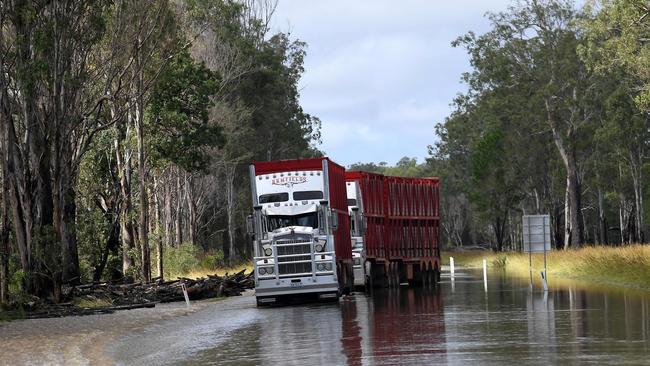Key agency suggests shifting roads to ease flooding woes
Moving roads away from flood-prone areas has been suggested as one way to lessen the impact of severed supply chains on regional communities.
Rebuilding roads frequently damaged by extreme weather away from flood zones would limit severed supply chains and better protect regional populations, a leading transport authority says.
Transport for NSW has put forward the radical plan to build roads back better, saying traditional industry management was being challenged by dynamic changes in climate patterns and weather extremes.
The impact of severe weather events on the regional, rural and remote road network has been immense in recent months, with devastating floods cutting supply chains needed to move produce, and causing major infrastructure damage.
“Route realignment to avoid known areas of repeated or frequent impact is one opportunity for betterment works to improve network resilience,” a TNSW spokesman said.
“Improving or developing transport networks that are less susceptible to – or that are likely to return to service more quickly following – a natural disaster is one way to improve connectivity and help communities to get back to normal sooner.”

Longstanding federal and state government policy is for critical infrastructure, such as roads and bridges, to be repaired back to the same standard as before being damaged.
However, a $312.5 million flood recovery package for 26 disaster-declared councils in northern NSW, announced last year by the Albanese Government, for the first time included policy settings for roads to be improved to withstand future extreme natural weather events.
Emergency Management Minister Murray Watt said by rebuilding to a better standard “we can protect communities during disasters, while also lessening the long-term damage to regions”.
While the TNSW realignment suggestion – put forward to parliamentary inquiry into the rural road network – is potentially costly, the Australian Local Government Association said more than $3.8 billion in road and related infrastructure damage was caused by recent severe weather across NSW, Victoria and Queensland.
National Farmers Federation CEO Tony Mahar said in a submission to the same inquiry that up to 50 per cent of the final price of grain can go towards freight and logistics.
“These ludicrous costs for Australian farmers only further spiral when severe weather events create additional delays and inefficiencies on the road network,” he said.
“It would be irresponsible of the Australian Government to fail to use road infrastructure repairs to also support enhanced resilience and robustness of infrastructure to withstand future climate change-induced stresses.”

The NFF has previously called for $1 billion over four years to be given to councils affected by flooding to rebuild roads to a standard more resilient to future disaster events.
Nationals leader David Littleproud said like-for-like restoration was no longer fit-for-purpose and believed the TNSW suggestion of moving infrastructure where possible was “common sense”.
Mr Littleproud, a former Morrison government emergency services minister, said while the upfront cost of shifting roads where possible would be expensive, “the long-term savings and payback would be more significant”.
A spokesman for Victoria’s Department of Transport and Planning said the authority was “always working to improve our roads”.
“In the wake of October’s devastating floods, we’ve used a range of methods to help future-proof our roads, including rebuilding some road surfaces above flood levels or using different materials to build stronger, more resilient roads,” he said.



